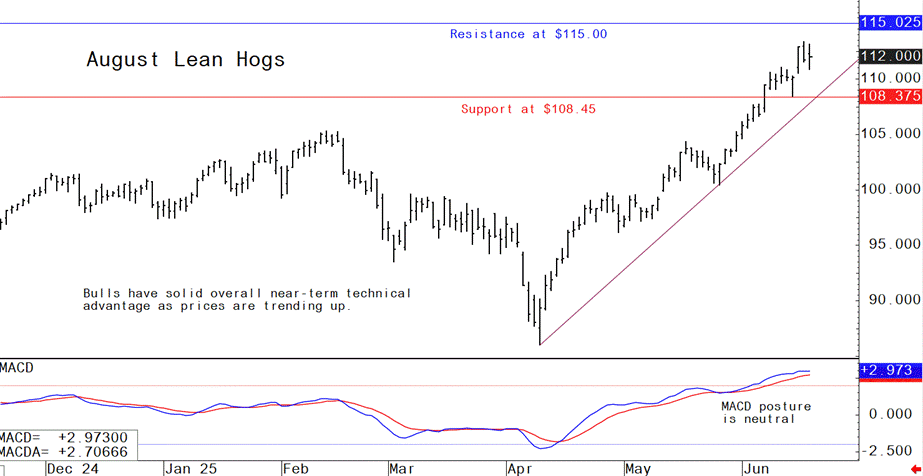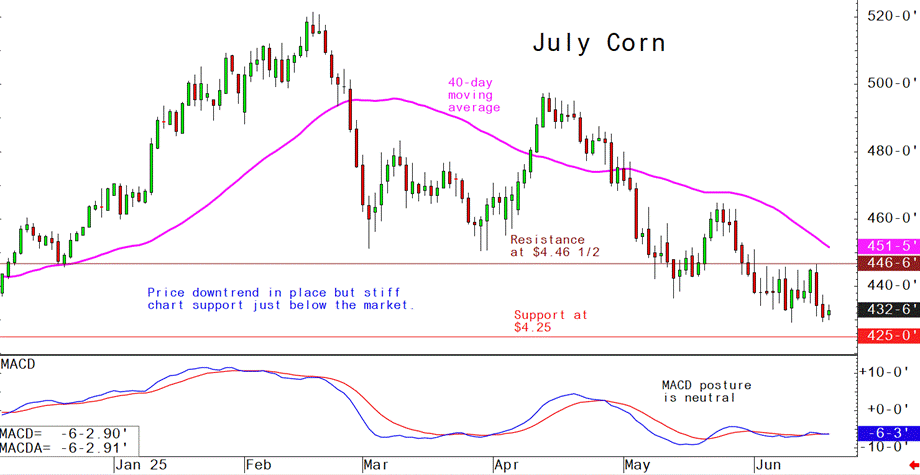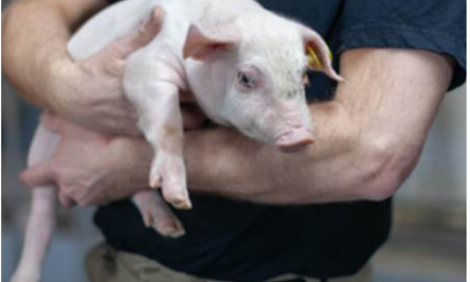



Pig outlook: Lean hog futures bulls remain in control
Livestock analyst Jim Wyckoff reports on global pig newsLean hog futures set contract highs this week. Any downside pullbacks have been limited as robust strength in cash hog and park market fundamentals continue to underpin futures. The latest CME lean hog index is up another $1.25 to $104.95 as of June 16, marking the largest daily gain of the ongoing seasonal rally. The hog index will this week reach the highest quote since August of 2022. The soaring beef and cattle markets are also underpinning the bull markets in pork and hogs.
China’s pork imports surge in May
Monthly and year-to-date growth reflects stronger demand
China’s pork imports reached 90,000 metric tons (MT) in May, marking a 12.5% increase from April and an 11.7% rise compared to May of the previous year. This uptick highlights a rebound in demand for imported pork, likely driven by domestic supply constraints and evolving consumer preferences.
Through the first five months of 2025, China’s cumulative pork imports totaled 450,000 MT, which is 5.8% higher than the same period in 2024. This sustained growth suggests that China is relying more heavily on international pork suppliers to meet domestic consumption needs.
Outlook: Analysts expect China’s pork import volumes to remain robust in the coming months, especially if domestic production remains volatile or if consumer demand continues to rise. The country’s import trends are closely watched by global pork exporters, as China remains the world’s largest pork consumer and a key driver of international trade flows.
China targets ‘refattening’ as government cracks down on speculative pig fattening
Beijing moves to slim down hogs, stabilize pork market and curb grain waste
China is ramping up efforts to curb the speculative practice of “refattening” pigs, as authorities seek to stabilize volatile pork prices and cut down on costly feed waste amid the ongoing U.S. trade war. According to Reuters, small Chinese breeders and farmers have increasingly bought market-ready pigs from large breeders and fattened them for extra months — hoping to profit if pork prices rise. This “refattening” adds 40-50kg to each hog, but analysts warn it leads to big price swings and inefficiencies. “It can lead to short-term shortages followed by a glut, driving big price swings and unsettling the market,” said Pan Chenjun, senior animal protein analyst at Rabobank.
China’s top pig breeder, Muyuan Foods, confirmed it recently halted sales to refatteners after rumors of a government policy crackdown. Sources told Reuters that Guangdong province is especially strict in enforcing the new rules.
Regulators worry the practice worsens oversupply and deepens pork price drops. Cash hog prices have slumped from 21 yuan/kg last August to just 14 yuan/kg since February, with weak demand and eroded margins.
Feed efficiency is also in focus as Beijing pushes to cut grain use — especially soybeans, a key import from the U.S. “Pigs are most efficient at around 120 kg—beyond that, they eat more but grow less,” Pan added.
Of note: The National Development and Reform Commission and Muyuan Foods declined Reuters’
requests for comment.
USDA monthly beef, pork, poultry and dairy report for June
The total U.S. red meat and poultry production forecast for 2025 is lowered from last month.
- Beef production is lowered on reduced steer and heifer slaughter in the second quarter and reduced cow slaughter for the remainder of the year.
- Pork production is unchanged from the previous month. The Quarterly Hogs and Pigs report, to be released on June 26, will provide indications of supplies of hogs for slaughter in the outlying quarters as well as into early 2026.
- Broiler production is raised on recent production and hatchery data.
- Turkey production is lowered on recent hatchery data.
- Egg production is lowered on recent layer inventory data, as well as recent discoveries of Highly Pathogenic Avian Influenza (HPAI) in commercial laying flocks.
For 2026, red meat and poultry production is raised on higher beef and turkey production. Beef production is raised primarily on higher feedlot placements in the second half of 2025 and early 2026, which are expected to result in higher steer and heifer slaughter for 2026. Turkey production is raised on improved returns. The pork and broiler production forecasts are unchanged.
EXPORT FORECAST: The beef export forecast for 2025 is raised on recent trade data and continued strong demand from key export markets. The beef import forecast is also raised on strong imports from Oceania and South America, as well as robust domestic demand for lean processing beef.
The pork export forecast is reduced for 2025 on recent trade data and increased export competition. For 2026, pork exports are also reduced on continued export competition.
The 2025 broiler export forecast is raised based on recent trade data indicating higher shipments in the second quarter. The broiler export forecast for 2026 is unchanged. The turkey export forecasts for 2025 and 2026 are lowered as higher U.S. prices are expected to make exports less competitive in destination markets.
PRICE FORECAST: Cattle price forecasts for 2025 are raised on recent price strength and continued demand for cattle. The increased price forecasts are carried over into 2026 as well. Hog price forecasts are raised for 2025, based on recent prices, as well as relatively tight pork inventories and increased cattle prices supporting hog demand. Raised hog price forecasts carry over into early 2026. Broiler price forecasts are raised for the second half of 2025 and into 2026, supported by higher prices of competing animal proteins. Turkey price forecasts are also raised for 2025 and 2026 based on recent price strength. The egg price forecast for 2025 is lowered slightly for the third quarter based on recent prices, but the price forecast for 2026 is unchanged.
Milk production forecasts are raised for both 2025 and 2026. Based on the latest Milk Production report, cow inventories are raised for 2025 and milk per cow is raised for both 2025 and 2026. For 2025 and 2026, commercial exports forecasts are raised on a fat basis, primarily due to competitively priced butter exports, as well as higher cheese and fluid product exports.
On a skim solids basis, export forecasts are reduced on lower shipments of nonfat dry milk (NDM). Import forecasts for 2025 are raised on both a fat basis and skim-solids basis. For 2026, imports are raised on a skim-solids basis, but unchanged on a fat basis. For 2025, butter, cheese, whey, and NDM price forecasts are raised from the previous month on recent price strength. The all milk price forecast is raised to $21.95 per cwt. For 2026, butter, cheese, and whey price forecasts are raised as strong demand is expected to absorb the growth in milk production. NDM prices are unchanged from the previous month. Class III and Class IV price forecasts are raised as well. The all milk price forecast for 2026 is $21.30 per cwt.
The next week’s likely high-low price trading ranges:
August lean hog futures--$108.45 to $115.00 and with a sideways-higher bias
July soybean meal futures--$280.00 to $295.00, and with a sideways bias
July corn futures--$4.25 to $4.46 1/2 and a sideways bias
Latest analytical daily charts lean hog, soybean meal and corn futures












